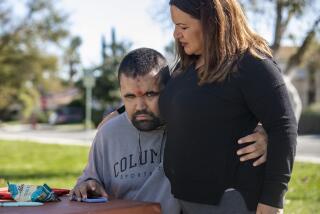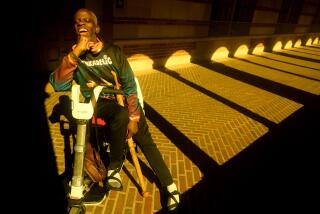Violence Against the Mentally Disabled Poses Dilemma for Families
- Share via
NEW YORK — One girl was riding her bicycle. The other was heading home from middle school. Both were mentally disabled. Both were gang-raped.
The attacks occurred within two weeks of each other this fall, on opposite sides of the country.
While authorities in Marietta, Ga., and Berkeley pursued 30 suspects, ranging in age from 11 to 25, advocates for the developmentally disabled absorbed the grim news without surprise.
“There is an epidemic of violent crime against this population,” said Daniel Sorensen, chairman of the California Victims of Crime Committee. “What is amazing is how invisible this problem has been.”
Studies over the last decade suggest that mentally disabled people are at least four times more likely than other Americans to be targets of sexual assault and other violence. Some studies indicate that more than 75% of mentally disabled women are sexually abused.
While most Americans may be scarcely aware of this problem, parents of disabled children know the dangers all too well--and yet are torn about how to respond.
Many families now view mental institutions skeptically, as last-resort options that guarantee neither immunity from abuse nor an optimal living environment. But the recommended alternative--”mainstreaming” a disabled child as part of the community at large--brings its own set of risks.
“The reality is that just putting them away somewhere doesn’t make them safer,” said Wendy Abramson, who runs a safety awareness program in Austin, Texas, for families with developmentally disabled children.
“It is a balancing act,” Abramson said. “How can I make sure this person is safe and yet help them participate in their communities? It is a dilemma. It is complex. It is scary.”
Rosemary Alexander, a special-education coordinator in Austin, has felt those fears as she watched her severely disabled son move through childhood.
“My son at 18 can’t talk, can’t read, can’t write,” she said. “He’s very vulnerable. He doesn’t have a way to tell us what’s happened; he doesn’t have the skills to defend himself, to avoid trouble coming his way.”
Alexander said her “best defense” is to screen the people who help care for her son, but she anticipates new worries when he eventually moves into a group home.
“With underpaid staff and a high turnover rate, he could be much more vulnerable,” she said. “You have to get to know the people, drop in often, make unexpected visits.”
For all her worries, she wants her son to be part of society.
“I’ve always believed he needs as many opportunities as possible to meet a wide variety of people in a wide variety of settings,” Alexander said. “He needs to be out there--so I just hope for the best.”
Dick Sobsey, a professor of educational psychology at the University of Alberta, is one of North America’s leading experts on violence against the disabled. His research suggests that many disabled people are abused by their caretakers in institutions, and many others are abused by relatives.
“Unfortunately, the risk is there in all of these places,” he said in a telephone interview. “There was better cover-up in the institutions. I think that’s still the case.”
Although reluctant to provide specific advice to families, he offered some general guidelines.
“Parents should pay attention if their children give a feeling that something’s not safe, that maybe they are uncomfortable spending time with someone,” Sobsey said. “It doesn’t mean the situation is always abusive, but paying attention to those signals makes sense.”
He urged families to establish a network of acquaintances who care about the disabled person.
“Having friends in the neighborhood helps keep people safe more than it puts them at risk,” he said. “Trying to keep someone isolated often backfires.”
Sorensen, whose severely brain-damaged son died at age 30, said many parents inadvertently raise their developmentally disabled children to be “perfect victims.”
“We often deny their sexuality,” he said. “That’s wrong. . . . People with disabilities need to be given information about their emerging sexuality and the tools to ensure their personal safety.”
Abramson said her program in Austin encourages families to provide education about sexuality.
“A person with disabilities may have a gut feeling that something has happened they know is wrong,” she said. “If they haven’t been given education about different kind of touches that are OK and not OK, they’ll be less likely to communicate it. A lot don’t receive that kind of education.”
A pilot violence-prevention program has been developed by the Arc of Maryland, a branch of one of the major national groups championing developmentally disabled people. The eight-course curriculum involves role playing and the concept of yes/yes and yes/no activities: Do each of two people want to continue with a certain activity, or only one of them?
In some instances, mentally disabled people are attacked by assailants unaware of their condition. But Sorensen says many assailants target disabled people as “easy pickings” who can be preyed upon with minimal fear of arrest.
Sorensen said there are major obstacles to equal justice for disabled people: Attacks against them often go unreported, and they often are viewed as untrustworthy witnesses.
“I met one woman who said she never went more than a year without being sexually assaulted in institutions--more than 30 attacks in all,” he said. “She told people about every case. Nothing was ever done.”
Sorensen likened violence against the mentally disabled to child abuse and domestic violence --phenomena that many Americans ignored or underestimated for decades before widespread awareness gradually evolved. He said he was stunned when he first read a study nine years ago about the extent of crime targeting disabled victims.
“I couldn’t believe it,” he said. “I read three or four more studies. It’s something we’d all been in a collective deep sleep about.”
Now, even as he battles for funding and political support, Sorensen believes progress in inevitable.
“Nine years ago, maybe 20 people in the whole continent were working on this issue. Today there are several hundred,” he said. “We’re past the stage of not dealing with it; you can’t stuff it back in the box.”
Justice Department background on crime against the disabled: https://www.ojp.usdoj.gov/ovc/factshts/disable.htm.
More to Read
Sign up for Essential California
The most important California stories and recommendations in your inbox every morning.
You may occasionally receive promotional content from the Los Angeles Times.













